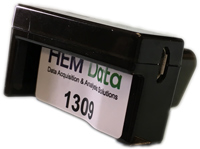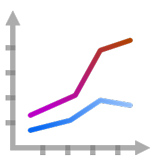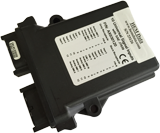 HEM Data is pleased to announce that it has written a book entitled Data Acquisition from Light-Duty Vehicles Using OBD and CAN. It is published by SAE and available from SAE and directly from HEM Data.
HEM Data is pleased to announce that it has written a book entitled Data Acquisition from Light-Duty Vehicles Using OBD and CAN. It is published by SAE and available from SAE and directly from HEM Data.
The book is a guide for the reader on how to acquire and correctly interpret data from the in-vehicle network of light-duty (LD) vehicles.
Written by two specialists in this field, Richard P. Walter and Eric P. Walter of HEM Data, the book provides a unique road map for the data acquisition user. The authors give a clear and concise description how to determine what data is available on the vehicle’s network, acquire messages and convert them to scaled engineering parameters, apply more than 25 applicable standards, and understand 15 important test modes. Topics featured in this book include:
- Calculated fuel economy
- Duty cycle analysis
- Capturing intermittent faults
Data Acquisition from Light-Duty Vehicles Using OBD and CAN is a must-have reference for product engineers, service technicians, fleet managers, government agencies, and all interested in acquiring data effectively from light-duty and medium duty vehicles.
Order now by phone (248) 559-5607 or (800) 436-4330.
The book price is $75 and with shipping from HEM Data it is $85 in the U.S. For worldwide purchases, we recommend buying the e-book directly from SAE.
CHAPTER 1 Benefits and Applications of the In-Vehicle Network for Data Acquisition
1.1 Overview: Data Goldmine
1.2 Focus and Assumptions of This Book
1.3 Access to the Data
1.4 Normal and Requested Messages
1.4.1 Normal Messages
1.4.2 Requested Messages
1.5 Comparing Light- and Heavy-Duty Vehicle Designs
1.6 Applications
1.7 How to Use This Book
CHAPTER 2 Comparison with Traditional Data Acquisition
2.1 Acquiring Data with Added Sensors
2.2 In-Vehicle Network Data
2.3 Acquiring Parameters from the Network
2.4 Complications of Network versus Direct Sensors
CHAPTER 3 Binary, Hex, Bits, and Bytes
3.1 Introduction to Bits, Binary, and Hexadecimal Conventions
3.2 Hexadecimal Designations
3.3 Introduction to Bits and Bytes
3.4 11 and 29-Bit CAN IDs
3.5 Data Conventions
3.5.1 Conversion Format
3.5.2 Byte Format
3.5.3 Byte Order
CHAPTER 4 Controller Area Network (CAN) Protocol
4.1 What Is CAN
4.2 What Does CAN Define
4.2.1 Layer 1: Physical Layer
4.2.2 Level 2: Data Link Layer
4.3 Applications of CAN
4.4 CAN on Light-Duty Vehicles Using ISO 15765
CHAPTER 5 On-Board Diagnostics (OBD) Background and Standards
5.1 OBD Background
5.2 Relevant OBD-II Standards
5.2.1 OBD and Protocol Relationship
5.2.2 OBD-II Information Defined in J1979
5.2.3 Legacy OBD Protocols
5.2.4 ISO 15765: OBD-II on CAN
5.3 Additional OBD-II-Related Standards
5.3.1 J1930: Terms and Definitions
5.3.2 J1962: Diagnostic Connector
5.3.3 J1978: Diagnostic Tool Requirements
5.3.4 J2012: Diagnostic Trouble Code (DTC) Definitions
5.3.5 J2186: Data Link Security
5.3.6 J2534: Recommended Practice for Pass-Thru Vehicle Programming
5.3.7 J1699: Vehicle OBD-II Compliance Test Cases Recommended Practice
5.3.8 J1699-3: Vehicle OBD-II Compliance Test Cases
5.3.9 J1699-4: OBD-II Communications Anomaly List
5.3.10 J2284-3: High-Speed CAN (HSC) for Vehicle Applications at 500 kbps
5.3.11 J3005-1 Permanently or Semi-Permanently Installed Diagnostic Communication Devices
5.3.12 J3005-2 Permanently or Semi-Permanently Installed Diagnostic Communication Devices—Security Guideline
CHAPTER 6 OBD-II Diagnostic Messages and Test Modes
6.1 J1979 and J1979-DA: Electrical/Electronic Systems Diagnostic Test Modes
6.1.1 Priority
6.1.2 Controller IDs
6.2 Test Mode
6.2.1 Mode $01: Request Current Powertrain Diagnostic Data
6.2.2 Mode $02: Request Powertrain Freeze Frame Data
6.2.3 Mode $03/$04: Request/Clear Emission-Related Diagnostic Trouble Code (Confirmed DTCs)
6.2.4 Mode $05: Request Oxygen Sensor Monitoring Test Results
6.2.5 Mode $06: Request On-Board Monitoring Test Results for Specific Monitored Systems
6.2.6 Mode $07: Request Emission-Related Diagnostic Trouble Codes Detected During Current or Last Completed Driving Cycle (Pending DTCs)
6.2.7 Mode $08: Request Control of On-Board System, Test, or Component
6.2.8 Mode $09: Request Vehicle Information
6.2.9 Mode $0A: Request Emission-Related Diagnostic Trouble Codes with Permanent Status
6.3 Parameter ID (PIDs)
6.3.1 PID $00: Finding Available Parameters
6.4 Broadcast vs. Targeted Requests
6.5 11- and 29-Bit CAN Message Examples
CHAPTER 7 J1979 OBD-II Data with Mode $01
7.1 Overview
7.2 Mode $01 – Request Current Powertrain Diagnostic Data
7.3 Required OBD-II Mode $01 Parameters
7.3.1 Required OBD-II, Mode $01 Parameters – Gasoline Engines
7.3.2 Required OBD-II, Mode $01 Parameters – Diesel Engines
7.4 Sample Rate, Scaling, and Amplitude Resolution for Mode $01 Parameters
7.5 Sample Message Data and Conversion for Test Mode $01
7.5.1 Example 1 Vehicle Speed ($0D)
7.5.2 Example 2 Intake Air Temperature ($0F)
7.5.3 Example 3 RPM ($0C)
7.6 Example OBD Database Editor
CHAPTER 8 Mode $06: Request On-Board Monitoring Test Results for Specific Monitored Systems
8.1 Purpose
8.2 Diagnostic Monitor ID (MIDs): Component Identifier
8.3 Test IDs (TIDs)
8.4 Data Format
8.5 Data Display of Mode $06 Data
8.6 Oxygen Sensor
8.7 Supported MIDs
8.8 PID $41: Monitor Status This Driving Cycle
8.9 Mode $06 Serial Monitor
8.10 Mode $06 Parallel Monitor
8.11 Logging Mode $06
8.12 The Missing Mode
CHAPTER 9 Enhanced Diagnostics
9.1 Comparing OBD-II to EOBD
9.2 Enhanced OBD Test Modes
9.3 Sources of LD Network Data
9.4 J2190 Enhanced E/E Diagnostic Test Modes
9.5 ISO 14229: Unified Diagnostic Services (UDS)
9.6 ISO14230: Road Vehicles—Diagnostic Communication over K-Line (DoK-Line)
9.7 ISO 15765 Road Vehicles: Diagnostic Communication over Controller Area Network (DoCAN)
9.7.1 General Information and Use Case Definition
9.7.2 Transport Protocol and Network Layer Services
9.7.3 Implementation of Unified Diagnostic Services (UDS on CAN)
9.7.4 Requirements for Emissions-Related Systems
CHAPTER 10 Additional Protocols
10.1 LIN Protocol
10.2 MOST Protocol
10.3 FlexRay Protocol
10.4 Automotive Ethernet
10.4.1 Time-Triggered Ethernet
10.5 CAN FD
10.6 Protocol Speed Summary
10.7 OBD-III
CHAPTER 11 Diagnostic Trouble Codes (DTCs)
11.1 Overview
11.2 J1979 OBD-II Fault Codes (Modes $03, $07, $0A)
11.3 UDS ISO 14229 EOBD Fault Codes
11.4 Comparing HD and LD Standards
11.4.1 Comparing HD and LD Approaches
11.4.2 Comparing LD Test Modes with HD Messages
11.5 J1939 Fault Codes
11.6 WWH-OBD Fault Codes
11.6.1 Severity (Byte 4 of Request and Byte 5 of Response)
11.6.2 Class of the DTC Severity (Byte 7)
11.6.3 Status (Byte 11)
11.7 Clearing Codes
11.7.1 Clearing OBD Codes
11.7.2 Clearing EOBD Codes
11.7.3 Clearing J1939 Trouble Codes
CHAPTER 12 Steps to Acquire LD In-Vehicle Network Data
12.1 Overview
12.2 Logging OBD Data with a Test Tool
12.3 Example OBD Database Editor
12.3.1 Selecting Parameters to Acquire
12.3.2 Sorting by Name, Unit, or PID
12.3.3 Defining the Acquisition Rate and Source Address
12.3.4 Importing Proprietary Messages
12.4 Data Logger/Streamer Specifications
CHAPTER 13 Applications and Example Data
13.1 Overview of OBD Applications
13.2 Web-Based Dashboards
13.3 Types of Analyses and Displays
13.3.1 Point-by-Point Trip Data
13.3.2 Statistical Data
13.3.3 Vehicle Comparison Data
13.3.4 Correlating Controller Data
13.4 Fleet Data
13.4.1 Diagnostics and Alerts
13.4.2 Driver Behavior/Performance/Training
13.4.3 Electronic Logging Device (ELD)
13.5 Diagnosing and Servicing Intermittent Problems
13.5.1 Air Conditioning Intermittent Problem
13.5.2 Transmission Intermittent Problem
13.6 Additional Data Sources
13.6.1 GPS
13.6.2 Geofencing
13.6.3 Telematics and Remote Diagnostics
13.6.4 Adding Sensors to the Vehicle
13.7 Calculated Parameters from In-Vehicle Network Parameters
13.7.1 Vehicle Weight
13.7.2 Triaxial Accelerometer and Road Grade
13.7.3 Fuel Economy
CHAPTER 14 Calculating Fuel Economy
14.1 Fuel Economy and Emissions
14.2 Calculating Fuel Economy
14.2.1 Injector Volume
14.2.2 Manifold Air Flow and Air Fuel Ratio
14.2.3 Using Manifold Air Pressure (MAP) and Ideal Gas Law
14.3 Fuel Economy Studies
14.3.1 Conclusions from HEV Testing
14.3.2 Conclusions from Fleet Testing
14.3.3 Conclusions from the Fleet Study
14.4 PEMS from PAMS
CHAPTER 15 Reverse Engineering Messages
15.1 Reverse Engineering EOBD Mode $21 or $22
15.2 Reverse Engineering Normal Messages
15.3 Software
15.4 Example OBD-II, EOBD, and Normal Data
15.4.1 Example OBD-II Data
15.4.2 Example EOBD Data using Mode $22
15.4.3 Example Normal Data
CHAPTER 16 Data Storage and Transfer
16.1 File Size
16.1.1 Estimating File Size
16.1.2 File Format and Compression
16.2 Data Transfer Options and Data Rates
16.2.1 WiFi
16.2.2 Cellular
16.2.3 Bluetooth
16.2.4 USB
16.3 Real-Time vs. Logged Data
16.3.1 Real-Time Data
16.3.2 Logging
16.3.3 Acquisition, Storage, Display, and Analysis Trade-Offs






